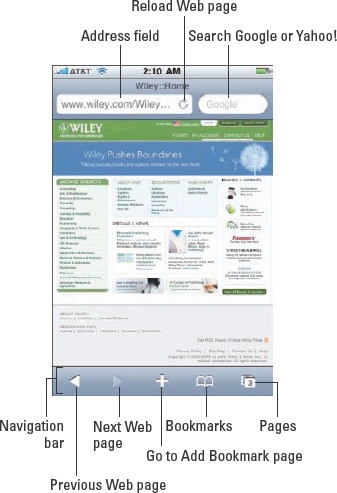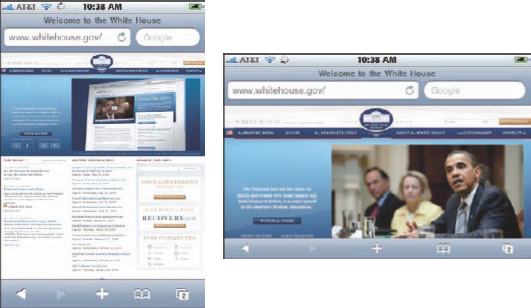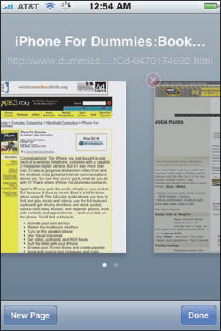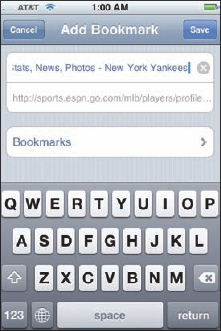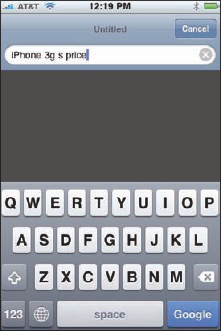Surfing the Net
Opening and displaying Web pages
Using a wireless network
Having fun with links, bookmarks, and history lists
Securing Safari
"The Internet in your pocket."
That's what Apple promised the iPhone would bring to the public when the product was announced in January 2007. Steve Jobs & Co. has come tantalizingly close to delivering on that pledge.
For years, the cell phone industry has been offering some sort of watered-down mobile version of the Internet, but the approaches have fallen far short of what you've come to experience while sitting in front of a computer.
Apple, however, has managed for the most part to replicate the real-deal Internet with the iPhone. Web pages look like Web pages on a Windows PC or Macintosh, right down to swanky graphics and pictures — and at least some video.
In this chapter, you find out how to navigate through cyberspace on your iPhone.

Note
A version of the Apple Safari Web browser is a major reason that the Net on the iPhone is very much like the Net you've come to expect on a computer. Safari for the Mac, and (more recently) for Windows, is one of the best Web browsers in the computer business. In our view, it has no rival as a cell phone browser.
We start our cyberexpedition with a quick tour of the Safari browser. Take a gander at Figure 10-1: Not all browser controls found on a PC or Mac are present. Still, Safari on the iPhone has a familiar look and feel. We describe these controls and others throughout this chapter.
Before plunging in, we recommend a little detour. Read the "Living on the EDGE" sidebar, earlier in this chapter, to find out more about the wireless networks that let you surf the Web on the iPhone in the first place.
So we tell you how great Web pages look on the iPhone and you're eager to get going. If you're reading this chapter from start to finish, we don't hold you back much longer.
When you start by tapping the address field, the virtual keyboard appears. You may notice one thing about the keyboard right off the bat: Because so many Web addresses end with the suffix .com (pronounced "dot com"), the virtual keyboard has a dedicated .com key. For other common Web suffixes — .edu, .net, .ee, and .org — press and hold the .com key and choose the relevant domain type.
Of equal importance, both the period (.) and the slash (/) are on the virtual keyboard because you frequently use them when you enter Web addresses.
The moment you tap a single letter, you see a list of Web addresses that match those letters. For example, if you tap the letter E (as we did in the example shown in Figure 10-2), you see Web listings for EarthLink, eBay, and others. Tapping U or H instead may display listings for USA TODAY or the Houston Chronicle (shameless plugs for the newspapers where Ed and Bob are columnists).
The iPhone has two ways to determine Web sites to suggest when you tap certain letters. One method is the Web sites you already bookmarked from the Safari or Internet Explorer browsers on your computer (and synchronized, as described in Chapter 3). More on bookmarks later in this chapter.
The second method iPhone uses when suggesting Web sites when you tap a particular letter is to suggest sites from the History list — those cyberdestinations where you recently hung your hat. Because history repeats itself, we also tackle that topic later in this chapter.
You might as well open your first Web page now — and it's a full HTML page, to borrow from techie lingo:
Tap the Safari icon at the bottom of the Home screen.
It's another member of the Fantastic Four (along with Phone, Mail, and iPod).
Tap the address field (refer to Figure 10-1).
If you can't see the address field, tap the status bar or scroll to the top of the screen.
Begin typing the Web address, or URL (Uniform Resource Locator, for trivia buffs), on the virtual keyboard that slides up from the bottom of the screen.
Do one of the following:
To accept one of the bookmarked (or other) sites that show up on the list, merely tap the name.
Safari automatically fills in the URL in the address field and takes you where you want to go.
Keep tapping the proper keyboard characters until you enter the complete Web address for the site you have in mind, and then tap Go in the lower-right corner of the keyboard.
It's not necessary to type www at the beginning of a URL. So, if you want to visit
www.theonion.com(for example), typingtheonion.comis sufficient to transport you to the humor site.
Warning
Even though Safari on the iPhone can render Web pages the way they're meant to be displayed on a computer, every so often you may run into a site that serves up the light, or mobile, version of the Web site, sometimes known as a WAP site. Graphics may be stripped down on these sites. Alas, the producers of these sites may be unwittingly discriminating against you for dropping in on them by using a cell phone. Never mind that the cell phone in this case is an iPhone. You have our permission to berate these site producers with letters, e-mails, and phone calls until they get with the program.
If you know how to open a Web page (if you don't, read the preceding section, "Blasting off into cyberspace"), we can show you how radically simple it is to zoom in on the pages so that you can read what you want to read and see what you want to see, without enlisting a magnifying glass.
Try these neat tricks:
Double-tap the screen so that that portion of the text fills up the entire screen: It takes just a second before the screen comes into focus. By way of example, check out Figure 10-3. It shows two views of the same Sports Illustrated Web page. In the first view, you see what the page looks like when you first open it. In the second one, you see how the picture takes over much more of the screen after you double-tap it. To return to the first view, double-tap the screen again.
Pinch the page: Sliding your thumb and index finger together and then spreading them apart (or as we like to say, unpinching) also zooms in and out of a page. Again, wait just a moment for the screen to come into focus.
Press down on a page and drag it in all directions, or flick through a page from top to bottom: You're panning and scrolling, baby.
Rotate the iPhone to its side: Watch what happens to the White House Web site, shown in Figure 10-4. It reorients from portrait to a wide-screen view. The keyboard is also wider, making it a little easier to enter a new URL.
When we surf the Web on a desktop PC or laptop, we rarely go to a single Web page and call it a day. In fact, we often have multiple Web pages open at the same time. Sometimes, it's because we choose to hop around the Web without closing the pages we visit. Sometimes, a link (see the next section) automatically opens a new page without shuttering the old one. (If these additional pages are advertisements, they aren't always welcome.)
Safari on the iPhone lets you open multiple pages simultaneously. Tap the Pages icon (refer to Figure 10-1), on the right side of the navigation bar at the bottom of the screen, and then tap New Page on the screen that pops up next. Tap the address field and type a URL for your new page.
The number inside the Pages icon lets you know how many pages are open. To see the other open pages, flick your finger to the left or right, as shown in Figure 10-5. Tap a page to have it take over the full screen.
To close one of your open Web pages, tap the white X in the red circle, which appears in the upper-left corner of each open page.
Surfing the Web would be a real drag if you had to enter a URL every time you want to navigate from one page to another. That's why bookmarks are so useful. And, it's why handy links are welcome too. Because Safari functions on the iPhone the same way browsers work on your PC or Mac, links on the iPhone behave much the same way too.
Text links that transport you from one site to another are underlined. Merely tap the link to go directly to that site.
But tapping on some other links leads to different outcomes:
Open a map: Tapping on a map launches the Google Maps application that is, um, addressed in Chapter 12.
Prepare an e-mail: Tap an e-mail address and the iPhone opens the Mail program (see the next chapter) and prepopulates the To field with that address. The virtual keyboard is also summoned so that you can add other e-mail addresses and compose a subject line and message. This shortcut doesn't work in all instances in which an e-mail appears on the Web.
Make a phone call: Tap a phone number embedded in a Web page and the iPhone offers to dial it for you. Just tap Call to make it happen, or tap Cancel to forget the whole thing.
Tip
To see the URL for a link, press your finger against the link and keep it there. Use this method also to determine whether a picture has a link.
Warning
Not every Web link cooperates with the iPhone. As of this writing, the iPhone didn't support some common Web standards — notably, Adobe Flash video and Java. It's a void that we hope is addressed — and Apple can apply this type of upgrade (if it so chooses) by distributing a software update. With OS 3.0 software, Apple added support for the emerging standard HTML 5 and HTTP streaming of audio and video. In the meantime, if you see an incompatible link, nothing may happen — or a message may be displayed about having to install a plug-in.
You already know how useful bookmarks are and how you can synchronize bookmarks from the browsers on your computer. It's equally simple to bookmark a Web page directly on the iPhone:
Make sure that the page you want to bookmark is open, and tap the + symbol in the bottom middle area of the screen.
You have the opportunity to tap Add Bookmark, Add to Home Screen, or Mail Link to this Page. Figure 10-6 shows the Add Bookmark screen, which appears when you tap Add Bookmark. The screen arrives with a default name and folder location.
To accept the default bookmark name and default bookmark folder, tap Save.
To change the default bookmark name, tap the X in the circle next to the name, enter the new title (using the virtual keyboard), and then tap Save.
To change the location where the bookmark is saved, tap the > symbol in the Bookmarks field, tap the folder where you want the bookmark kept, tap the Add Bookmark button in the upper-left corner of the screen, and then tap Save.
To open a bookmarked page after you set it up, tap the Bookmarks icon at the bottom of the screen (refer to Figure 10-1) and then tap the appropriate bookmark.
If the bookmark you have in mind is buried inside a folder, tap the folder name first, and then tap the bookmark you want.
Tip
If you tapped Add to Home Screen rather than the Add Bookmark option in Step 1 of the preceding set of steps, your iPhone adds an icon to your Home screen to let you quickly access the site. If you tapped Mail Link to this Page instead, the Mail program opens, with a link for the page in the message and the name of the site in the subject line.
If a bookmarked site is no longer meaningful, you can change it or get rid of it:
To remove a bookmark (or folder), tap the Bookmarks icon and then tap Edit. Tap the red circle next to the bookmark you want to toss off the list, and then tap Delete.
To change a bookmark name or location, tap Edit and then tap the bookmark. The Edit Bookmark screen appears, showing the name, URL, and location of the bookmark already filled in. Tap the fields you want to change. In the Name field, tap the X in the gray circle and then use the keyboard to enter a new title. In the Location field, tap the > symbol and scroll up or down the list until you find a new home for your bookmark.
To create a new folder for your bookmarks, tap Edit and then tap the New Folder button. Enter the name of the new folder and choose where to put it.
To move a bookmark up or down on a list, tap Edit and then drag the three bars to the right of the bookmark's name.
Sometimes, you want to revisit a site that you failed to bookmark, but you can't remember the darn destination or what led you there in the first place. Good thing you can study the history books.
Safari records the pages you visit and keeps the logs on hand for several days. Tap the Bookmarks icon, tap History, and then tap the day you think you hung out at the site. When you find it, tap the listing. You're about to make your triumphant return.
Tip
To clear your history so that nobody else can trace your steps — and just what is it you're hiding, hmm? — tap Clear at the bottom of the History list. Alternatively, tap Settings on the Home page, tap Safari, and then tap Clear History. In both instances, per usual, you have a chance to back out without wiping the slate clean.
Most of us spend a lot of time using search engines on the Internet. And, the search engines we summon most often are Google and Yahoo! So it goes on the iPhone.
Although you can certainly use the virtual keyboard to type google.com or yahoo.com in the Safari address field, Apple doesn't require that tedious effort. Instead, you tap into Google or Yahoo! by using the dedicated search box shown in Figure 10-7. The default search engine of choice on the iPhone is Google, and Yahoo! is the first runner-up.
To conduct a Web search on the iPhone, tap the search field shown earlier, in Figure 10-1. The field expands and temporarily replaces the address bar at the top of the screen, and the virtual keyboard slides up from the bottom. Enter your search term or phrase, and then tap the Google (or Yahoo!) button in the lower-right corner of the keyboard to generate pages of results. Tap any search results that look promising.
Tip
To switch the search box from Google to Yahoo! and vice versa, tap Settings on the Home page, scroll down and tap Safari, tap Search Engine, and then tap to choose one search behemoth over the other.
You can capture most pictures you come across on a Web site — but be mindful of any potential copyright violations, depending on what you plan to do with the image. To copy an image from a Web site, press your finger against the image and tap the Save Image button that slides up (along with a Cancel button and a Copy button), as shown in Figure 10-8. Saved images end up in your Camera Roll, from which they can be synced back to a computer. If you tap Copy instead, you can paste the image into an e-mail or as a link in a program such as Notes.
Along with the riches galore found on the Internet are places in cyberspace where you're hassled. You might want to take pains to protect your privacy and maintain your security.
Return with us now to Settings, by tapping the Settings icon on the Home page. Now tap Safari.
You may have already discovered how to change the default search engine and clear the record of the sites you visited through Settings. Now see what else you can do:
Fill out forms with AutoFill: This capability arrived with OS 3.0 software. When AutoFill is turned on, Safari can automatically fill out Web forms by using your personal contact information, usernames and passwords, or information from other contacts in your address book.
Clear cookies: We're not talking about crumbs you may have accidentally dropped on the iPhone. Cookies are tiny bits of information that a Web site places on the iPhone when you visit so that the Web site recognizes you when you return. You need not assume the worst: Most cookies are benign.
If this concept wigs you out, you can take action: Tap Clear Cookies at the bottom of the screen and then tap it again (rather than tap Cancel). Separately, tap Accept Cookies and then tap Never. Theoretically, you will never again receive cookies on the IPhone. A good middle ground is to accept cookies only from the sites you visit. To do so, tap From Visited. You can also tap Always to accept cookies from all sites.
Warning
If you don't set the iPhone to accept cookies, certain Web pages don't load properly.
Tap Safari to return to the main Safari settings page.
Clear the cache: The cache stores content from some Web pages so that they load faster the next time you stop by. Tap Clear Cache and then tap Clear Cache again on the next screen to (you guessed it) clear the cache.
Turn JavaScript on or off: This setting is on when the blue On button is showing and off when the white Off button is showing. Programmers use JavaScript to add various kinds of functionality to Web pages, from displaying the date and time to changing images when you mouse over them. However, some security risks have also been associated with JavaScript.
Turn plug-ins on or off: These are typically associated with certain types of video.
Block pop-ups: Pop-ups are those Web pages that show up whether you want them to or not. Often, they're annoying advertisements. But at some sites, you welcome the appearance of pop-ups, so remember to turn off blocking under such circumstances.
Use Developer: Unless you happen to be a developer, we don't ask you to pay much attention to this setting. It lets you turn a debug console (showing errors, warnings, tips, logs, and similar details that developers find useful) on or off.
Taming Safari is just the start of exploiting the Internet on the iPhone. In upcoming chapters, you discover how to master e-mail, maps, and more.

